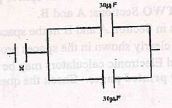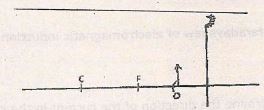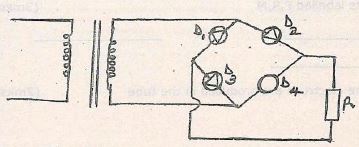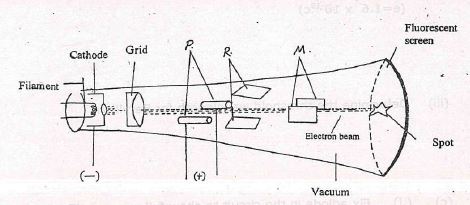PHYSICS
PAPER 2
TIME: 2 HOURS.
Instructions to candidates
- Answer ALL the questions
- This paper consists of TWO Sections: A and B.
- ALL working MUST be clearly shown.
- Mathematical tables and electronic calculators may be used.
SECTION A: 25 MARKS
Answer ALL questions in the spaces provided on the question paper.
- Photo electrons emitted by a certain metal surface constitute a "Photo current". State the effect of increasing the intensity of illumination on the magnitude of the "photo current" (1mk)
- Sketch a displacement-time graph for a wave with an amplitude of 1m and a frequency of 5HZ (3 mks)
- State two differences between the eye lens and the lens of a camera. (2 mks)
- Define polarization as used in simple cells and state how it can be minimized. (2 mks)
- The figure below shows an arrangement of three components. If the total capacitance of the capacitors is 5uf, calculate the value of x. (3 mks)
- The figure below shows a wire in a magnetic field. When a current is switched on to flow through the wire, it moves as shown by the arrow. Draw and indicate the direction the magnetic field. (2 mks)
- An accelerating potential of 2kV is applied to an X-ray tube. Calculate
- The kinetic energy of the electrons emitted (3 mks)
- The velocity of these electrons (take the charge on an electron to be 1.6 x 10-19 (and the mass of an electron to be 9.0 x 10-31 Kg) (2 mks)
- An object O is placed in front of a concave mirror and on the principal axis, as shown in the figure below. Complete the light ray diagram to locate the position of the image. (3 mks)
- You are given three resistors of values 51, 81 and 1212. Show in circuit diagram how you would connect them so as to give an effective resistance of 9.8.22. (3 mks)
- The figure below shows a block diagram of a p-n junction diode
On the same diagram, show how a cell may be connected to make it reverse biased
SECTION B (55 MARKS)
Answer ALL questions in the spaces provided on the question paper
-
-
- State snell's law (1 mk)
- The diagram below shows a transparent tank containing water. An electric lamp covered with shield which has narrow slit is fixed at one corner of the tank. A light ray from the slit reaches the water surface at an angle of 420 as below nw = 1.33
Determine the angle of refraction for the ray (2 mks) - Determine angle of indence for which the angle of refraction is 90° (2mks)
-
- State faradays law of electromagnetic induction(1mk)
- Determine the direction of the current in the coil in the set up below. Label the polarity at the points marked X and Y (2mks )
- A transformer has 1000 turns in its primary coil, which is connected to a 250V a.c supply. The secondary coil is connected to an ammeter via a 100 Ohm resistor. Determine the number of turns in the secondary coil of the ammeter reads 1.5A (3mks)
-
-
- The figure below is part of the electromagnetic spectrum in order of increasing wavelength
A B C Visible light Infrared radiation D E - How are waves B produced (2mks)
- State two uses of the waves (2mks)
- Explain how are infrared waves detected (1mk)
-
- State the reason why the speed of sound is greater in a solid than in air? (1mk)
- An echo sounder produces a pulse and an echo is received from the seabed after 0.4 seconds. If the speed of sound in water is 1500m/s. Calculate the depth of the seabed. (2mks)
- The figure below is part of the electromagnetic spectrum in order of increasing wavelength
-
- What is meant by background radiation (1mk)
- A 32 g sample of a radioactive substance was reduced to 2 g in 96 days. How much would remain after another 96 days. (3mks)
- Americium-241, strontium -90 and cobalt-60 are known sources of alpha, beta particles and gamma rays respectively. All the three sources are placed in front of the obstacles shown below
- An attempt is then made to detect the particles/radiations at points A,B and C using a Geiger-Muller. Which particle(s)/radiations are detected at points (3mks)
- State two dangers of radioactive emissions (2mks)
- An attempt is then made to detect the particles/radiations at points A,B and C using a Geiger-Muller. Which particle(s)/radiations are detected at points (3mks)
- Radium (Ra) 226 decays by alpha emission to Radon (Rn). The atomic 2017 number of Ra is 88.
- Write down an equation to show this decay. (2mks)
- Rn is radioactive and decays by alpha emission to polonium (Po) while Po can decay by beta emission according to the equation
Determine the values of E, F and G (3mks)
-
- The following are work functions of some metal surfaces
Sodium 2 electron Volts (eV)
Beryllium 3.9eV
Magnesium 2.8eV- Define 'work function' of a surface? (1mk)
- Find work function of magnesium in joules (1mk)
(e=1.6 x 10-19c) - Determine the threshold wavelength for Beryllium
-
- Fix adiode in the circuit to show full wave rectification (1mk)
- Explain how doping produces a p-type semiconductor. (3mks)
- Fix adiode in the circuit to show full wave rectification (1mk)
- The following are work functions of some metal surfaces
-
- Define the term thermionic emission. (1mks)
- The figure below shows the main components of a cathode ray tube. Use it to answer the questions that follow
- Name the parts labelled P,R,M (3mks)
- Explain how the electrons are produced in the tube (2mks)
- State and explain the function of the grid (2 mks)
- State and explain what would be observed on the screen if an a.c.voltage is connected across the y- plate (1mk)
- State how the deflection system of a television differs from that of a C.R.O. (1mk)
MARKING SCHEME
SECTION A: 25 MARKS
Answer ALL questions in the spaces provided on the question paper.
- Photo electrons emitted by a certain metal surface constitute a "Photo current". State the effect of increasing the intensity of illumination on the magnitude of the "photo current" (1mk)
- Number of photoelectrons produced increase; hence more photocurrent.
- Number of photoelectrons produced increase; hence more photocurrent.
- Sketch a displacement-time graph for a wave with an amplitude of 1m and a frequency of 5HZ (3 mks)
- State two differences between the eye lens and the lens of a camera. (2 mks)
Eye lens Camera lens f variable F fixed constant Take one photo at a time
V varies for zoom lens - Define polarization as used in simple cells and state how it can be minimized. (2 mks)
- Formation of hydrogen bubbles
- Use depolarizer, eg potassium dichromate
- The figure below shows an arrangement of three components. If the total capacitance of the capacitors is 5uf, calculate the value of x. (3 mks)
- 30 + 30 = 60
1/x + 1/60 = 1/5
5 = 60x
60 + x
300+ 5x = 60x
55x = 300
X= 5.45
- 30 + 30 = 60
- The figure below shows a wire in a magnetic field. When a current is switched on to flow through the wire, it moves as shown by the arrow. Draw and indicate the direction the magnetic field. (2 mks)
- An accelerating potential of 2kV is applied to an X-ray tube. Calculate
- The kinetic energy of the electrons emitted (3 mks)
½mv2 = ev
=1.6 x 10-19 x 2 x 100
=3.2 x 10-16J - The velocity of these electrons (take the charge on an electron to be 1.6 x 10-19 (and the mass of an electron to be 9.0 x 10-31 Kg) (2 mks)
3.2 x 10-16 = ½ x 9 x 10-31 x v2
V=3.2 x 10-16
4.5 x 10-31
V = √7.1 x 10-31
V = 2.66m/s x 10-31
- The kinetic energy of the electrons emitted (3 mks)
- An object O is placed in front of a concave mirror and on the principal axis, as shown in the figure below. Complete the light ray diagram to locate the position of the image. (3 mks)
- You are given three resistors of values 51, 81 and 1212. Show in circuit diagram how you would connect them so as to give an effective resistance of 9.8.22. (3 mks)
8 x 12 = 96 = 4.8
8 + 12 20
4.8 + 5 = 9.8 - The figure below shows a block diagram of a p-n junction diode
On the same diagram, show how a cell may be connected to make it reverse biased
SECTION B (55 MARKS)
Answer ALL questions in the spaces provided on the question paper
-
-
- State snell's law (1 mk)
- h = Sin i
Sin r
- h = Sin i
- The diagram below shows a transparent tank containing water. An electric lamp covered with shield which has narrow slit is fixed at one corner of the tank. A light ray from the slit reaches the water surface at an angle of 420 as below nw = 1.33
Determine the angle of refraction for the ray (2 mks)- wna = 1
1.33
(90 - 42 - 48)
1 = sin 48
1.33 sin r
r = sin-1 (1.33 sin 48)
r =82.14°
- wna = 1
- Determine angle of indence for which the angle of refraction is 90° (2mks)
1.33= 1
sin-1 = 0.7519
Sin c
C = 48.76
- State snell's law (1 mk)
-
- State faradays law of electromagnetic induction(1mk)
- magnitude of induced emf is directly proportional to rate of change of magnetic flux linkage
- magnitude of induced emf is directly proportional to rate of change of magnetic flux linkage
- Determine the direction of the current in the coil in the set up below. Label the polarity at the points marked X and Y (2mks )
- A transformer has 1000 turns in its primary coil, which is connected to a 250V a.c supply. The secondary coil is connected to an ammeter via a 100 Ohm resistor. Determine the number of turns in the secondary coil of the ammeter reads 1.5A (3mks)
- Ns = 1.57 x 100
1000 250
Ns = 150000
250
=600 turns
- Ns = 1.57 x 100
- State faradays law of electromagnetic induction(1mk)
-
-
- The figure below is part of the electromagnetic spectrum in order of increasing wavelength
A B C Visible light Infrared radiation D E - How are waves B produced (2mks)
- in an X-rays tube when stream of fast moving electrons hit a metal target
- in an X-rays tube when stream of fast moving electrons hit a metal target
- State two uses of the waves (2mks)
- X-ray photograph
- Cancer therapy
- Control of pests .
- Crystallography
- Explain how are infrared waves detected (1mk)
- Thermopile
- Thermometer with blackened bulb
- Bolometer
- Or heating effect produced on skin
- How are waves B produced (2mks)
-
- State the reason why the speed of sound is greater in a solid than in air? (1mk)
- Closely packed molecules vibrate and transfer sound to next molecule in a shorter time.
- Closely packed molecules vibrate and transfer sound to next molecule in a shorter time.
- An echo sounder produces a pulse and an echo is received from the seabed after 0.4 seconds. If the speed of sound in water is 1500m/s. Calculate the depth of the seabed. (2mks)
- V = 2d/t
d = 1500 x 2
0.4
d = 7500m
- V = 2d/t
- State the reason why the speed of sound is greater in a solid than in air? (1mk)
- The figure below is part of the electromagnetic spectrum in order of increasing wavelength
-
- What is meant by background radiation (1mk)
- Radioactive emissions that are not from unstable, elements
- Radioactive emissions that are not from unstable, elements
- A 32 g sample of a radioactive substance was reduced to 2 g in 96 days. How much would remain after another 96 days. (3mks)
- 32 - 16 - 8 - 4 - 2 = 4 half lifes
96/ 4 = 24 days
2 - 1 - 0.5 - 0.25 = 1/8
- 32 - 16 - 8 - 4 - 2 = 4 half lifes
- Americium-241, strontium -90 and cobalt-60 are known sources of alpha, beta particles and gamma rays respectively. All the three sources are placed in front of the obstacles shown below
- An attempt is then made to detect the particles/radiations at points A,B and C using a Geiger-Muller. Which particle(s)/radiations are detected at points (3mks)
- Alpha, Beta, Gamma -
- Beta
- None
- State two dangers of radioactive emissions (2mks)
- Over exposure leads to cancer
- Overexposure leads to skin burn
- An attempt is then made to detect the particles/radiations at points A,B and C using a Geiger-Muller. Which particle(s)/radiations are detected at points (3mks)
- Radium (Ra) 226 decays by alpha emission to Radon (Rn). The atomic 2017 number of Ra is 88.
- Write down an equation to show this decay. (2mks)
- 226 4He 222
Ra 2 Po
88 → 86
- 226 4He 222
- Rn is radioactive and decays by alpha emission to polonium (Po) while Po can decay by beta emission according to the equation
Determine the values of E, F and G (3mks)
222 4He 218
Ra 2 Po
86 → 84
E= 218
F = 84
G=218
- Write down an equation to show this decay. (2mks)
- What is meant by background radiation (1mk)
-
- The following are work functions of some metal surfaces
Sodium 2 electron Volts (eV)
Beryllium 3.9eV
Magnesium 2.8eV- Define 'work function' of a surface? (1mk)
- Minimum epergy below which no photoelectrons are emitted.
- Minimum epergy below which no photoelectrons are emitted.
- Find work function of magnesium in joules (1mk)
(e=1.6 x 10-19c)- 2.8 1.6 x 10-19
- 2.8 1.6 x 10-19
- Determine the threshold wavelength for Beryllium
- w=hc/λ
= 3.9 x 1.6 x 10-19
=634 x 10-34 x 3 x 108
Λ
λ=
- w=hc/λ
- Define 'work function' of a surface? (1mk)
-
- Fix adiode in the circuit to show full wave rectification (1mk)
- Explain how doping produces a p-type semiconductor. (3mks)
- Doping with trivalent
- Hole remains, 3 e's from trivalent bond
- With intrinsic semiconductor
- Holes become majority charge carriers
- Fix adiode in the circuit to show full wave rectification (1mk)
- The following are work functions of some metal surfaces
-
- Define the term thermionic emission. (1mks)
- Emission of e's by heat
- Emission of e's by heat
- The figure below shows the main components of a cathode ray tube. Use it to answer the questions that follow
- Name the parts labelled P,R,M (3mks)
- P-Anode
- R-Y-plates
- M -X-plates
- Explain how the electrons are produced in the tube (2mks)
- Thermionic emission
- Cathode is heated liberates e's that are accelerated
- State and explain the function of the grid (2 mks)
- Controls number of o's emitted; hence brightness of screen
- Grid move negative, few e's cross to screen hence less bright
- Grid less negative
- State and explain what would be observed on the screen if an a.c.voltage is connected across the y- plate (1mk)
- 2 d. diagram seen
- Gives deflection in x-plates and deflection along y-axis
- State how the deflection system of a television differs from that of a C.R.O. (1mk)
- That of television by magnetic coils while that of C.R.O by clectric field,
- Name the parts labelled P,R,M (3mks)
- Define the term thermionic emission. (1mks)
Download Physics Paper 2 Questions and Answers - Mang'u Mock 2020 Exam.
Tap Here to Download for 50/-
Get on WhatsApp for 50/-
Why download?
- ✔ To read offline at any time.
- ✔ To Print at your convenience
- ✔ Share Easily with Friends / Students

















